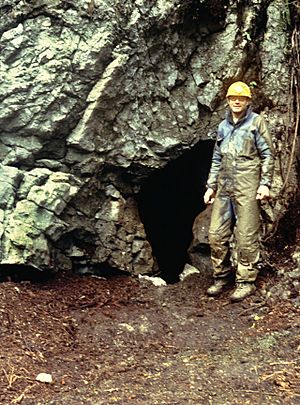On Your Knees Cave facts for kids

Timothy H. Heaton at the entrance of On Your Knees Cave
|
|
| Location | Prince of Wales Island |
|---|---|
| Coordinates | 56°20′00″N 133°35′30″W / 56.33333°N 133.59167°W |
| Site notes | |
| Archaeologists | Timothy H. Heaton |
| Management | Tongass National Forest |
On Your Knees Cave (also known as 49-PET-408) is an important archaeological site. It is located in southeastern Alaska, on Prince of Wales Island. In 1996, scientists found human remains inside the cave. These remains are about 10,300 years old.
Besides the human bones, researchers also found stone tools and animal bones. DNA tests on the human remains showed a specific genetic group. This group, called mitochondrial haplogroup D, is common in the Americas. Studies of the bones also showed that the person ate mostly seafood.
Contents
Where is On Your Knees Cave?
On Your Knees Cave is on the northern tip of Prince of Wales Island. It is part of the Tongass National Forest. The cave is about one kilometer (0.6 miles) from the coast. It sits 125 meters (410 feet) above sea level.
When it was first found, large rocks and soil blocked the cave entrance. These had fallen from the cliff above. After clearing the way, the small opening gave the cave its unique name. Inside, there is a long, low tunnel. Old bear dens can be found throughout the cave.
How the Cave Was Discovered
The Tongass Cave Project first found the site in 1993. This project was a team effort. It included the Tongass National Forest and the National Speleological Society. The next year, they started exploring old bear dens inside the cave. They soon found many animal bones.
Scientists found bones from many different animal species. Some of these animals are now extinct on the island. After finding the animal bones in 1994, Timothy Heaton led the research. He was a paleontologist from the University of South Dakota. Fred Grady from the Smithsonian Institution helped him. Brian Kemp and E. James Dixon also helped with the studies.
In 1996, the team found human bones. This discovery changed the focus of their research. The human remains included parts of a jawbone, a pelvis, and other small pieces. They also found five vertebrae and several teeth. Stone tools were mixed in with the animal and human bones. These tools were made from obsidian. Obsidian is a type of volcanic glass. Finding it suggests that people traded or traveled across water and land.
Why On Your Knees Cave is Important
On Your Knees Cave is one of the oldest known human settlements. It is located along the Northwest Coast of North America. Scientists took DNA from one of the human molars. The genetic tests showed that the person, named Shuká Káa, was a male. Further study of his teeth showed he died in his mid-twenties.
His mitochondrial DNA (mtDNA) showed he belonged to a subgroup of haplogroup D. This is the earliest time this haplogroup has been found. This genetic group is often found in people along the western coast of the Americas. The Tlingit people live near the discovery site today. They gave DNA samples to compare with Shuká Káa. However, their DNA did not match. This means Shuká Káa and modern Alaska Native American tribes are likely not closely related. But this does not mean ancient Alaskan Native American groups were not related to him.
Scientists also studied the human bones to learn about the person's diet. These studies showed that he ate almost entirely marine protein, meaning seafood. The cave is on an island. This suggests that people used boats and lived off the sea a very long time ago in this area.
One hundred animal bones from the cave were carbon-14 dated. This dating showed that animals used the cave almost continuously for the past 40,000 years. This means the island was never completely covered by glaciers. It was always a place where animals could live. The stone tools found in the cave were made there. But the materials, like obsidian, were not from the island. Since the cave is on an island, researchers think the people living there were mariners. They could cross bodies of water using boats. The evidence from this site supports the idea that the first Americans traveled along the coast. This idea was first suggested by K.R. Fladmark in 1979.
Protecting Ancient Remains
After finding the human remains in 1996, work at On Your Knees Cave paused. This was done to follow the Native American Graves Protection and Repatriation Act (NAGPRA) of 1990. This law protects Native American graves and cultural items.
Timothy Heaton and other project leaders contacted local tribal governments. They wanted to find out who owned the remains. It was decided that the Tlingit people of Southeastern Alaska were the rightful owners. The Tlingit people were at first unsure about letting scientists test the remains. But they finally agreed to allow studies of the bones and more digging. They asked to be told about any new discoveries. This led to a 12-year partnership between the Tlingit tribe and the scientists. After studying the human remains, they were returned to the Tlingit people. They held a reburial ceremony and a celebration festival.
Who Paid for the Research?
Many groups helped fund the research at On Your Knees Cave. These included the National Science Foundation, National Geographic Society, Tongass National Forest, University of South Dakota, and National Speleological Society.
Documentary Film
A documentary film has been made about the cave. It is called Kuwóot yas.éin, which means "His Spirit is Looking Out From the Cave." The Sealaska Heritage Institute made this film.


